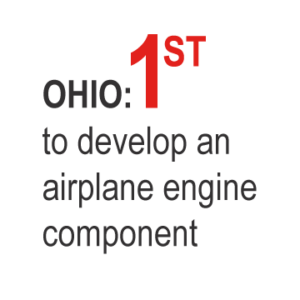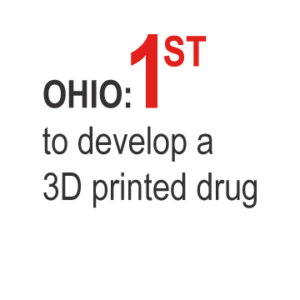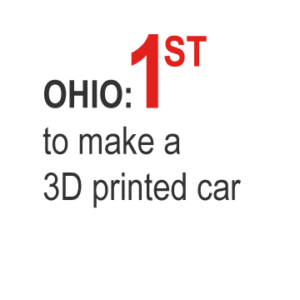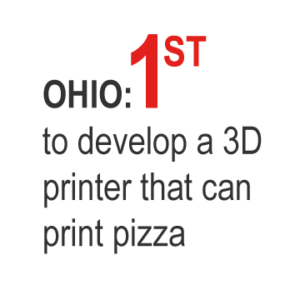Additive Manufacturing
Ohio’s Robust Additive Manufacturing Ecosystem is the Extra Dimension Businesses Need to Succeed
Ohio is the nation’s additive manufacturing center of excellence, with the partnerships, talent, and resources that make it the best place for additive manufacturing companies to invest in their future. With the first National Innovation Institute dedicated to additive manufacturing located in Youngstown, Ohio, the North East Ohio region leads in 3D printing innovation. Across partnerships in industry, academia, agencies, and the additive manufacturing workforce, innovations in Ohio have been developed for a broad range of industries, including defense, aerospace, healthcare, and industrial tooling.
Contact Us
“The Silicon Valley of 3D Printing”
Ohio is the place of many firsts in additive manufacturing technology innovation. The first airplane engine component was developed at General Electric (GE) Aviation. The first 3D printed drug was developed at Aprecia Pharmaceuticals. The first Big Area Additive Manufacturing printer at Cincinnati Incorporated made the first 3D printed car. And the first 3D printer that can print pizza was developed by BeeHex. It’s really no wonder that Ohio has been referred to as “the Silicon Valley of 3D printing,” (Gabriel Schlumberger, CEO of Fitz Frames).




Ohio’s Additive Manufacturing Partners and Assets
Partnership across the additive manufacturing supply chain means whether you’re a supplier or direct to consumer distributor, the partners you need to collaborate with to prototype and get your product to market are already here in Ohio.
Additive Manufacturing Networks
Based in Youngstown, Ohio, America Makes is the national accelerator for additive manufacturing. America Makes partners organizations from industry, academia, government, non-government agencies, workforce, and economic development resources to work together towards advancing additive manufacturing in the U.S.
NEO Additive Manufacturing Cluster of Ohio creates partnerships across the additive manufacturing supply chain including manufacturers, end-use markets, economic development organizations, professional associations, and higher education. Focusing on accelerating the use and adoption of 3D printing technologies, they are working toward five goals for achieving their vision.
Research Organizations
In Ohio, we know that research fuels additive manufacturing innovation. We have a long history of innovation and the partnerships to help you innovate, too:
EWI – Headquartered in Columbus, Ohio, EWI is an independent engineering consultancy with comprehensive labs and advanced manufacturing technology resources dedicated specifically to production process development and improvement. They also established the Additive Manufacturing Consortium to accelerate and advance the manufacturing readiness of metal additive manufacturing technology.
NASA Glenn Research Center – Located in Cleveland, Ohio, the NASA Glenn Research Center designs and develops technology to advance NASA’s missions in aeronautics and space exploration. NASA Glenn utilizes additive manufacturing technology in their research and product development.
Battelle – With their headquarters in Columbus, Ohio, Battelle conducts research and development, manages laboratories, and designs and manufactures products for multi-national corporations, small start-up organizations, and government agencies across the country. They offer 3D printing and rapid prototyping services to their clients.
Air Force Research Laboratory (AFRL) – Located at Wright-Patterson Air Force Base in Dayton, Ohio, research by AFRL has influenced nearly every aerospace technology in the last century and routinely utilize additive manufacturing in their product development.
University Research and Development Centers
Ohio University Innovation Center’s Additive Manufacturing Lab is open to anyone who wants to try 3D printing including designers, artists, engineers, product developers, and entrepreneurs. They offer assistance at any point in the process and utilize several product development tools including 3D printers and scanners.
Ohio State University's Center for Design and Manufacturing Excellence (CDME) works with companies and researchers to translate new technologies into real-world, market-ready manufactured products. These projects give student employees at CDME hands-on experience integrating new technology while providing customers with the workforce advantage necessary to compete in a global marketplace. The center executes this innovative approach to technology translation and workforce development while shaping the national conversation on advanced manufacturing innovation. CDME and Cincinnati Incorporated (CI), a U.S.-based, build-to-order machine tool manufacturer, partnered to provide the center with one of CI’s Medium Area Additive Manufacturing (MAAM) printers, an industrial-sized additive machine built for production manufacturing. This machine enables researchers and students to advance additive manufacturing technology and techniques by using cutting-edge 3D printing equipment.
University of Dayton Research Institute (UDRI)’s Advanced Technology and Training Center (ATTC) offers comprehensive capabilities and research services in additive manufacturing. Clients of the ATTC seek out UDRI’s additive manufacturing technology development, quality inspection services, and their cold spray repair technologies. UDRI’s additive manufacturing researchers are addressing the challenges of additive manufacturing including reverse engineering, design and qualification for AM, process validation and facility deployment, materials, and cybersecurity.
Case Western Reserve University’s Sears think[box] is the largest open-access innovation center and makerspace in the United States. Sears think[box] welcomes thousands of visitors each year at no cost looking for prototyping and fabrication equipment, space to brainstorm, legal and business support to commercialize intellectual property, or guidance to create market-ready products with real-world impact. At Sears think[box], Case Western students have launched startups, researchers have forged new partnerships, industry partners have discovered space to find new inspiration, and community members have turned part-time tinkering into full-time opportunities.
University of Cincinnati’s 1819 Innovation Hub offers a Ground Floor Makerspace and Microfactory. The Ground Floor is a space for students, faculty, staff, and partners to research, explore, and create new ideas, objects, and products. Making of all kinds is encouraged, including industry partnerships, academics, research, and engagement with maker-oriented student groups. Their mission is twofold: to empower the transformation of ideas into the material world; and to support innovation through the prototyping phase.
Ohio has the Talent Pipeline for Growth in Additive Manufacturing
The talent you need to grow your business is already here in Ohio, and we’re producing more and more talent each year that can help you bring your additive manufacturing goals to bear. Talent availability for 3D printing companies in Ohio is 2.3x higher than the U.S. average and the third highest among regional competitors. Much of this is due to Ohio’s educational institutions, many of which have designed additive manufacturing technology-specific coursework and programs to produce more graduates in these programs. For instance, The Ohio State University offers a Master of Global Engineering Leadership with an additive manufacturing track. Education institutions all over Ohio are recognizing the additive manufacturing industry growth, and dedicating resources to output more certifications, degree programs and other related educational credentials to match employer demand.
![]()
Talent availability in Ohio
for 3D printing is 2.3x
higher than the U.S.
average
![]()
Ohio has 240,000+
workers in key 3D printing
occupations
![]()
10,000+ engineering and
engineering technician
graduates per year in
Ohio
How Fitz Frames Found Success in Ohio’s Additive Manufacturing Ecosystem
Fitz Frames manufactures children’s eyewear using 3D printing technology. Founded in 2019 by co-CEOs Heidi Hertel and Gabriel Schlumberger, the company chose the Youngstown Business Incubator (YBI) for its manufacturing operation because of the area’s reputation for 3D printing and additive manufacturing, Hertel says. “The more research we did, the more we were impressed with the city and saw it to be the Silicon Valley of all things 3D printing,” Hertel says. “The community has been really supportive, and we have found solid talent coming out of the local universities.”
3D Printed Engines Take Flight from Ohio’s GE Aviation Additive Technology Center
GE Aviation has demonstrated its faith in 3D printing as well as in Cincinnati's talent and innovation infrastructure. In September 2015 the company moved its 3D printing development operation to a much larger location, tripling its floor space. Operating under the banner of the GE Aviation Additive Technology Center, the facility continues to focus on the advancement of 3D metal-based technology, building on the success of its 3D printed fuel nozzle for the LEAP engine and developing other applications for its aerospace turbine engine product lines.
3D Printing Company, Rugged 3D, Finds New Home in Ohio
Collin Boring, the founder and chief technology officer for the 3D printing company Rugged 3D, looked everywhere to find the right place to relocate his company from San Francisco — and found the Youngstown Business Incubator the best option. “I would have gone to the moon if that is where this type of ecosystem would have been,” he said. “It’s really important to me to put my company and its future somewhere where I know it can succeed. And that’s here,” he said.
Israeli Start-ups Get their Start in Youngstown, Ohio
The Israel Youngstown Business Incubator Collaborative plans to provide quality deal flow for technology-based Israeli start-ups so they can launch into the US Market. “Youngstown, the ecosystem we have here for additive manufacturing, is a great launching point for companies from Israel to come to launch their technologies here. I think vice versa with YBI portfolio company and original companies with additive manufacturing to bring goods to Israel as well,” said Brent Conner, YSU Director of Advanced Manufacturing and Workforce Initiative.
Ohio Offers Logistical Advantages
3D printing and digital distribution can present a unique logistical challenge, but Ohio has it covered. Through its lightning fast OARnet, which delivers internet speeds 3,000 times faster than the national average, 3D printing files get where they need to be quickly and reliably.

Whether you're a supplier or a business to consumer output operation, Ohio makes logistics a breeze from point A to point B. Industry leaders continue to choose Ohio because of its close proximity to everything they need to be successful, including materials, markets, and supplier partners. Plus, Ohio has a central location that maximizes market access. Businesses can reach 60% of the North American market within one day.
In addition, Ohio has:
![]()
The fourth largest
interstate highway
system
![]()
Four dedicated air
cargo terminals,
which is more than
any other midwestern
state
![]()
209 ports and
terminals along the
Ohio River and Lake
Erie, and the only
Great Lakes port with
access to Europe
![]()
13 intermodals
connected by the
fourth largest network
of railroads
Ohio is at the forefront of additive manufacturing and quickly becoming the center of excellence for this technology. Long known for its innovations, Ohio has a growing cluster of companies at the leading edge of innovation in additive manufacturing, and Ohio has a large talent pool skilled in both manufacturing and technology to support this growth. Our digital and physical infrastructures make it easier to connect with suppliers, customers, and partners so you can do business faster. In addition, Ohio is home to America Makes, a Manufacturing USA innovation institute that connects businesses with resources to accelerate advancements in additive manufacturing.
Some of the world’s most innovative additive manufacturing companies operate in Ohio because of our strategic advantages. Let those advantages become yours. Fill out the form below to learn more about opportunities in Ohio.
The Additive Manufacturing Industry Can Unlock Another Layer of Growth Potential in Your Company’s Supply Chain
What is additive manufacturing? And how does additive manufacturing work?
According to the International Organization for Standardization, additive manufacturing is a term for any technology that “create[s] physical objects by successive addition of material.” 3D printing is an additive manufacturing technology that allows designers to make three-dimensional objects by sending data to a machine that deposits material in layers to create the finished product. Designers may use computer aided design (CAD) applications to create new 3D objects, however it is also possible to use 3D scanners to replicate existing items. 3D printing materials may include plastics, metal, or even concrete depending on the application and hardware of the 3D printer.
What is an example of additive manufacturing?
Examples of additive manufacturing are present in several industries. In aerospace, 3D printing is being used to fabricate parts that are lighter but just as strong as their traditional counterparts. The medical industry requires specialized, and in some cases individualized instruments, models, and devices. With the advancements in additive manufacturing, medical professionals and patients alike benefit from highly specific objects printed for their treatment plans. In the energy industry, metal 3D printers utilizing corrosion-resistant materials are developing customized components that can withstand harsh conditions – even underwater.
Why is it called additive manufacturing?
The word ‘manufacturing’ is defined as making a finished product from raw materials by hand or by machinery while ‘additive’ is an adjective that describes something as being made by addition. When put together, the term ‘additive manufacturing’ is the perfect way to describe 3D printing technology, considering 3D printers create items by adding material one layer at a time.
What are the types of additive manufacturing?
There are seven types of additive manufacturing defined in 2010 by the International Organization for Standardization.
- VAT Photopolymerization – Also known as stereolithography, VAT polymerization involves a vat of liquid photopolymer resin and a build base that lowers down into the liquid. As the base lowers, a laser beam causes a reaction with the resin. Each layer is cured with a UV light, resulting in layers of hardened material until the object is complete.
- Material Jetting – Similar to traditional inkjet printers, material jetting uses a printhead above the build base that drips micro-droplets to form each layer of the object.
- Binder Jetting – After applying a powder-based material to a build base, a binder is deposited by the print head, which causes the layers to stick together.
- Material Extrusion – Material extrusion is the type of additive manufacturing most people are familiar with because at-home machines use this method. 3D printing material is pulled through a heated nozzle, melting it, and causing it to stick the layer beneath.
- Powder Bed Fusion – Requiring a near-vacuum, powder bed fusion uses a powder layer on the build base while a laser beam or electron beam heats the powder, hardening it into a layer. Another coat of powder is applied, hardening the powder while fusing it to the previous layer.
- Sheet Lamination – With sheet lamination, layers of material are fused to material on a cutting bed, with the object ultimately cut out with a knife or laser.
- Directed Energy Deposition – In this type of additive manufacturing, a multi-axis arm deposits material all around an object. The material is heated by either a laser or electron beam to harden it.